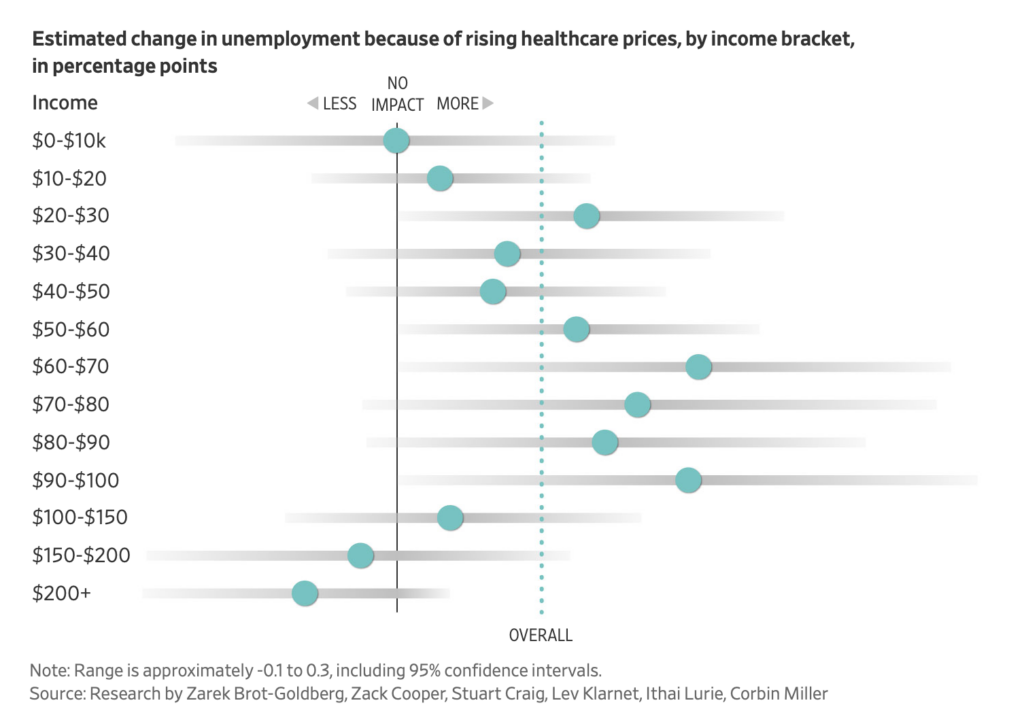Study Shows True Costs Of Health Care Spending Are Lives And Livelihoods
In mid-June, Medicare’s Office of the Actuary published its annual estimate of national health spending projections for the coming decade. As usual, the document concluded that health spending would rise ever higher, from nearly $4.5 trillion in 2022, or 17.3 percent of the entire economy, to more than $7.7 trillion, and just under 20 percent of GDP, in 2032.
Most Americans’ eyes tend to glaze over at these lofty projections of ever-growing health spending — or the long-term fiscal predicament it causes. A new study, however, provides much more tangible evidence as to the true effects of rising health care costs. In some cases, it costs people their jobs.
Effects of Hospital Mergers
The study, released by the National Bureau of Economic Research, attempts to get behind the reasons health costs increase. In some cases, rising health care costs could result from people in an area becoming wealthier and therefore spending more money on care. The researchers controlled for this variable by examining areas where hospitals merged — because such mergers are associated with increasing prices but no commensurate increase in health care quality.
The researchers examined hospital mergers, of which there have been many in recent years, to conclude that a 1 percent increase in health care prices led employers outside the health care sector to reduce payroll by 0.37 percent. Economists would generally agree with this conclusion, due to the belief that the “employer’s” share of health insurance premiums ultimately comes out of employees’ pockets. With total compensation (wages and benefits) being held constant, more money spent on insurance premiums means less money to spend on wages for workers.
Job Losses for the Middle Class
The study found that those payroll reductions come not just from businesses working employees fewer hours but from maintaining fewer employees overall, ultimately reflected through job losses. Those job losses had continued knock-on effects, in the form of lower income tax revenue and higher spending on unemployment benefits. The researchers even concluded that, because of the phenomenon of “deaths of despair” from individuals who leave the workforce, “we observe that a 1% increase in county-level health prices led to approximately one additional county-level death from suicides and overdoses per 100,000 people.”
Unfortunately, the study also concluded that middle-class workers get hit hardest by the job losses associated with higher health costs, for somewhat logical reasons. If health costs for every worker total $10,000, paying health benefits for a worker making $200,000 per year would raise that employee’s total compensation by 5 percent (i.e., $10,000/$200,000), but would raise the total compensation for a worker making only $50,000 by 20 percent ($10,000/$50,000), giving the employer a greater incentive to lay off the latter.
This trend doesn’t hold true at very low incomes — particularly below $20,000 — where workers often rely upon government programs such as Medicaid to cover health expenses, rather than employer coverage. An article in The Wall Street Journal highlighting the paper’s conclusions included a chart demonstrating how the employment effects exclusively hit middle-income workers:

Obamacare Killing Patients?
The study examined the years right around Obamacare’s enactment, when hospitals began gobbling up their competitors and physician practices to gain additional leverage in the brave new health care world. That fact makes the researchers’ conclusions all the more relevant:
Our estimates imply that the price growth between 2007 and 2014 reduced workers’ incomes by 2.7%, increased unemployment by approximately 0.86 percentage points (a 10% increase or 1.44 million jobs lost), lowered federal income tax revenues by 3.4%, and led to an increase in suicides and overdoses of 6.2 per 100,000 population (approximately 10,000 additional deaths across working-age adults). Based on the [Department of Transportation’s] 2015 value of a statistical life ($9.6 million), the economic value of this loss of life would be approximately $96 billion.
Somehow, Barack Obama and Joe Biden forgot to mention all of these knock-on effects when trying to sell the American public on Obamacare.
The study provides further evidence of the need to halt, and ideally reverse, the consolidation that plagues American health care. The middle class deserves better than a system that overcharges them, lowers their wages, and in some cases takes away their jobs.





Comments are closed.